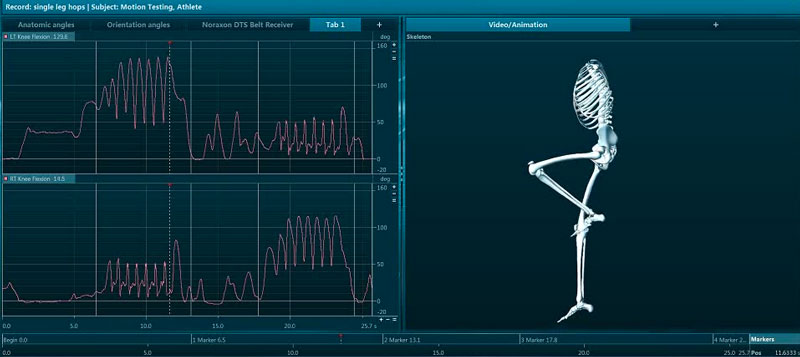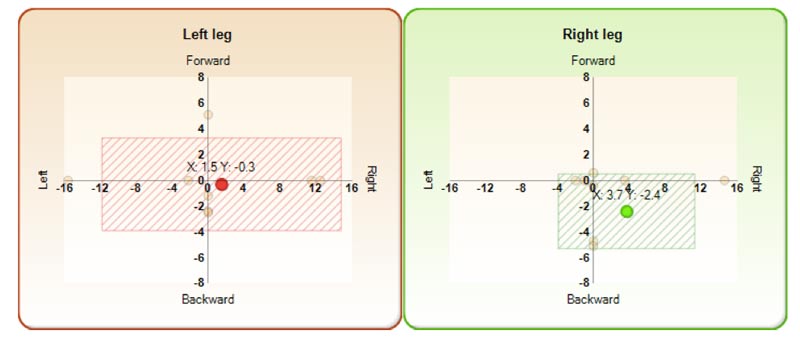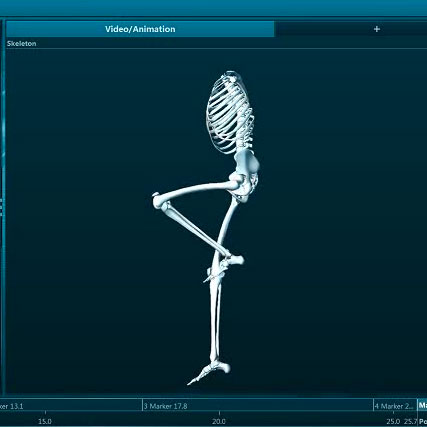
Figure 1: Single leg hops using the wireless EMG and motion capture is a powerful way to reduce injuries and identify areas that can be modified for performance.
By Carl Valle
Jump testing is commonly used to observe leg power, but every jump score is subject to interpretation. The goal for jump testing is to see how the training is affecting the jumping ability and seeing how training may influence running velocity at different parts of the acceleration curve. Often the wrong tests are used, or the right tests are administered poorly or incorrectly. In sport, improving jumping ability is important, but improving jumping ability doesn’t guarantee that one is going to run faster because they are jumping higher. Looking at the fastest athletes in the NFL combine, rarely do we see the highest jumpers have the fastest 40 times. On the other hand, no elite 40 performance at the combine has 18 inch jumpers, so global power matters, but running is much different than one countermovement jump with arms test. In this article, we will review great tests that have some influence in speed, and a good primer on this is the Al Vermeil article posted a few years ago. At the end of the day, speed predicts speed, and using jump tests to have confidence in what one is going to see on the clock is not the right thinking. A better option is to look at jump tests and see if the general power and elastic training is augmenting the scores, and how the scores might provide benefit to the running splits.
How I selected the Jump Tests
Some of you may be disappointed I didn’t include the common jump tests like vertical jumps or standing broad jump. It’s not that those tests are not valuable; it’s just that they didn’t crack the top five on my list for many reasons. First, the goal of the tests is to show strong value based on the data collected. Light jump squats in the weight room is where I placed the countermovement jumps and squat jumps because they fit nicely before power training. Jump tests to me are more about displacement horizontally and about getting more information besides height of the center of mass. Also, some tests are great for injury screening and efficiency since those areas tend to be valuable when one hits a genetic ceiling and coaches and athletes are forced to push to new levels. Some of the tests don’t require much equipment, and some do need a little investment. All tests should have some perspective and electronic timing is essential to see a potential cause and effect. Improving jumping for the most part directly improves jumping in general, but if you want to use plyometrics and various modalities to improve speed, you must time.

Modified Standing Triple
One of my problems with the triple jump test in track and field is that it’s great for jumpers, but not all athletes have access or skills of landing in a pit of sand. When times were rough and the winter required us to have alternate plans, we landed on high jump mats, but the landing is always a problem. To combat potential injury or variance from technique that can affect test data integrity, coaches should think about how they land and repeat the process with a reproducibility standardization. Remember, no rules exist in training, just good principles, science, and the art of applied coaching. Since no test will be that sensitive to equate to running speeds, legacy data of the conventional standing triple jump is only for comfort and not for transfer. The goal of the testing is to improve the numbers that mean something. Athletes should focus on improving their scores from training rather than just getting better from learning the test or artificially inflating scores from resting more than the baseline session.
The test evaluates a few power qualities, and that’s why I like the standing triple test provided it’s done consistently and the protocols are followed well. The main quality is global power of both legs and individual legs. Without much equipment besides a camera and a measuring tape, coaches can see how power is expressed bilaterally and how each leg is able to create power horizontally. Switching the legs so the first single leg explosion alternates between right and left can see more granularity of the previous explosive action and coaches can ensure improvement is coming from the right variables.
Landing is always a problem when athletes have poor training histories. I don’t do any horizontal testing until a year of athletic development because I constantly see a gap between power production and power reduction abilities. The aforementioned gap is increasing because physical education is now mimicking adult wellness programs and not movement competence development. I instruct a landing that is similar to a squat jump position to reduce athletes from reaching, meaning projecting their feet so far in front they are getting better scores from the kick-out rather than a change of their center of mass (true power increase). The key is making sure the test landing is safe and repeatable. I like the distance of the standing broad jump and the two leg explosions rather than just a raw total distance.
I see a strong relationship between this test and early acceleration because the takeoffs from both the dual leg jump and the bounds afterward include forefoot projections of the ankle complex and deep knee angles in general. Since the bounds will vary in technique, interpretation is more extensive but most will employ a full footed contact and not forefoot only, thus showing the hip involvement.

Repeated Elastic Jumping
Except for the first movement, all of the motions after departure are on one leg and are coming from the momentum of earlier actions. The elastic qualities are important, but double leg activities should be taken with a grain of salt. A good way to get global elastic ability is the use of repeated jumping for maximal output. Notice I never said for a set amount of repetitions or time. The reason? Athletes are not robots and tend to game the tests to get better scores, so one must be very careful in explaining the set-up of the test. An athlete knowing a certain duration (time component) or defined amount of reps may score better for average or poorer when trying too much each rep. The solution I have is to cue output and just let it go for as long as they can keep the effort up. What cueing does is remove earlier pacing on the jumps for duration and removes the paralysis by analysis with the set repetitions. My earlier post on weight room tests should have explained why I included a range of reps instead of defined reps for the Raptor test. Fatigue is very difficult to gauge unless baseline data is very solid and the measurements are very precise and the scores are fine. The problem with fatigue evaluation tests is that they will cause fatigue, and this ruins later workouts unless the test is a workout. I like elastic jumping because it overloads the entire leg, and it’s a great test that can be done year round. Sometimes specific stiffness below the knee is a rose with thorns; it is great to have at times but does cause a little pain if not handled right. By distributing the stress throughout the entire leg and including some hip activity, the test is more than just a stiffness test; it is a leg power with elastic utilization workout. Instead of the common 60 second test I like repeated sets of 20-30 seconds. What coaches can do with repeated outputs instead of one long death set is the ability to see the slope of power decay through the set and series of sets. Good data is not only valid but specific to the needs of the training program. Doing a death set is like shooting someone for autopsy data instead of doing a urine or blood test.
Interpreting the data is simple, and the key metrics are number of repetitions performed and the flight times compared to contact times in a given time. Unlike looking at stride length and stride frequency that requires kinematic analysis of posture and acceleration technique, repeated jumps are uniform in nature and are easier to evaluate. While the transfer and correlation are not a strong as obviously sprint timing splits and sprint training, the goal is to make significant improvement over years. The goal is not to reduce ground contact time. The goal is to improve elastic power that reduces ground contact time via more power, and the return should yield higher displacements (air time) and higher sustained averages. Just looking at decay of power without seeing absolute numbers is an error in how the athlete is pacing. Too long of ground contact times means the elastic energy is likely being compromised for higher flight times, so those numbers should be observed as well.

Bounding for Speed
Bounding for speed is not for everyone and sometimes plyometrics are not activities that are congruent with some orthopedic health problems of athletes. Plyometrics are demanding to tendons and joints, but while one can argue that so are sprints, the body is more likely tolerant to activities it was designed to do than to add exercises it can do artificially. Bounding for speed is something I rarely do with athletes because it requires that they are good jumpers, and this is likely to be solely a track and field test only. What I do like about it is that sprinters, jumpers, and hurdlers can see how reactive they are without using anything besides electronic timing. Doing a 20m fly with bounding can see if an athlete is able to handle their weight with specific power. The chart shared earlier can show velocity changes and this is a good resourceful for some lighter athletes who are skilled jumpers. Ground contact times and flight times with IR sensors are expensive when doing horizontal projection tests. Optojump is great but the OptoGait system is expensive. A pragmatic option is to look simply at horizontal velocity and the decay of it over two 10m splits. The goal is to see improvement over the second 10m after a 5-8m walk/trot/bound acceleration.
Video 1: Bounding for speed is about demonstrating the ability to maintain momentum and this video shows a lower speed bounding progression with a “trot” at medium run up velocity. The goal is to conserve speed from the horizontal approach and improve splits over time.
One question some people ask is it possible to switch to a one leg hop for speed instead of bounding. Yes, but be warned. Speed hopping is not evil, but it is very fatiguing because more hops or efforts are needed because the displacement is less, and the work is higher on the legs than bounding. A compromise is a 10m or similar distance instead of a flying 10, and only test athletes who are well developed and have superb technique. Remember that many team sports don’t do much training compared to Olympic sport, and wrongly porting “track and field” tests to team sport athletes is not wise. Even if one is a track and field athlete, a good foundation is needed as some track athletes are not developed but rather are just talented. On the other hand, if one lives in fear and compromises too much, athletes are in limbo and do things not to get hurt but never improve. Risk should be minimized but not preparing well is a risk for injuries.
Executing speed bounds or hops is about repeating a steady rhythm of great technique rather than a great performance time. By focusing on technique, scores will improve, but after mechanics stabilize look for changes in force capabilities. Again this test is not for everyone, but for talented athletes with great coaching backgrounds, the test is practical and a great training option. To help prevent poor landing technique, remind athletes that fast limbs don’t mean fast bodies. Using the Freelap Pro Coach is a good way to illustrate it is the rate of displacement of their center of mass (where the chip is) rather than how fast one feels.

Maximal RSI Tracking
I have learned a lot from working with athletes by just talking to sprinters and getting their opinions. When you are goal oriented, an athlete will constantly be thinking about getting better. One sprinter I have known for years added a small change to my thoughts on depth jumps and adding another box for better arousal. Targeting is a way increase output by having an object to reach, and that’s why I included backboard touches in my earlier article on Plyometric Workouts. Regardless of visual demand, sometimes output can be increased by tasks that are demanding, such as depth jumps onto a box of the same height. While I am not a fan of box jumps when the athlete is focusing on reaching with their feet rather than displacing their hips, adding a contact mat and video can help coaches with tracking training scores and comparing it to traditional RSI testing without horizontal displacement. Contact mats are good for binary information, meaning the equipment just really wants to know if contact is made on the ground and the data is limited. Flight time is not displacement; it’s just the duration between ground contacts and technique matters here. Athletes instinctively will try to stay in the air, even if they are honest and hardworking. A better way to use contact mats is to have goals and standards that reduce error and encouraging performance instead of getting “better numbers.”
The RSI or Reactive Strength Index was broken down in detail with the Depth Jump article, but one detail I needed to explain is height of the box and what the differences between maximal and readiness testing. Low box RSI testing is good to see freshness but not maximal potential. Remember the RSI is the ratio between contact time and flight time, sort of like the Testosterone to Cortisol ratio. Nothing wrong with ratios as they do help direct and summarize at times, but higher boxes are about the ability to express more power given the same contact time. Contact times are never going to reach foot contact times of sprinting, but the test isn’t about replicating; they are about maximizing. Provided the contact time stays the same, the ratio of the distance off the box and the landing of the center of mass on the next box is about equal. The goal is to ensure elastic energy is not lost or leaked from a height that is too high. What is the limit? I do have estimation of failure rates of Achilles tendons, but the goal is not to reach injury thresholds; the goal is to hit new adaptation levels. I hate putting a cap on anything, but 36-42 inches or about a meter is not evil. Some research shows an upper limit of 60 cm with ground contacts of .250 seconds, but like records, limits are made to be broken. Provided the contributions of elastic energy and force contributions are sanely enhanced, the overload is fine to use. Overload is tricky and while the athlete can use a penultimate step and create more efficient elastic contribution, the goal of depth jumps are not to maximally demonstrate elastic energy but maximally challenge it.
One question some coaches ask about depth jumps to another box is the recruitment of hip extensors being higher than just going up and down. The differences are there for longer ground contact times with horizontal displacements of about .80-1.20 meters from takeoff to landing, but I don’t know if this is something creating a unique benefit. I believe the option is doing rebound style depth jumps with some horizontal projection is better than just vertical landing because athletes are projecting forward from a box and our bodies are designed to redirect momentum. Research will validate this or prove it doesn’t matter, but for the meantime it’s a great way to challenge the body training wise and get good data. Focusing on keeping the ground contact under three-tenths a second and getting big air (displacement) is a good direction.

The Hop Drift Test
The last test is nothing new, as I mentioned it twice in earlier writings, with a specific highlight in the Top 5 Jumping Exercises for Speed Athletes article. The hop drift test is more of a screen than a performance test, but to me it’s worth doing because you can get a lot of information from it beyond just right and left power symmetry. The drift test does require near maximal effort with regards to hopping up and down, and using the Optojump can get four key data points. Jumping up and down with a contact mat or IR sensor (infrared sensors with Microgate equipment such as Optojump) give flight times and contact times easily. The added benefit with Optojump is that one can get left and right displacement of the foot landing as well as front to back changes as well. In summary, the Drift Test is getting how consistent the foot strike is and shows the spread of foot strikes over time. Comparing right and left, and you can see raw projection trends of each leg, and this can be very helpful in identifying dysfunctions and see patterns of foot kinetics and leg kinematics. The goal of the test is to screen quickly, not diagnose the issues the athlete is experiencing. In the future, wearable sensors will disrupt the Optojump system, and this is why I suggest going to a facility to outsource testing rather than invest into the equipment.

Figure 2: The Drift Test is a great way to look at both muscle/foot function and single leg power. Above is a view of the data coming from a soccer player in later stages of return to play rehabilitation.
Working around the lack of testing equipment can be done with the starting position and finishing position and the use of track markers and a good camera. The Drift Test is unique to Optojump, but a crude and valuable training and testing factor is using the painted lines of the track, specifically the marking of the lanes. When someone is testing without equipment, more manual effort is needed to get the same data, and the accuracy is usually compromised a bit. I like using video of 14 hops (two jumps to get started and two for ensuring the last are high efforts) to get ten solid in-place hops and see how much change is showing front-to-back and side-to-side. Don’t bother trying to measure because it will take hours of work with athletes and you are trying to look for gross problems on film for flagging who should get looked at deeper. If an athlete is feeling pain from old injuries or something is bothering him or her, don’t overreact and definitely don’t ignore, just refer to the right sports medicine person and let them deal with the issue. The takeaway is that the visual system can help make rapid adjustment to muscle recruitment and talented athletes hide dysfunctions and asymmetry problems. A weekend jogger can run pain and injury free because the resources needed to plod along the sidewalk is not the autobahn that requires maximal contraction subject to risks from fatigue and poor preparedness. Screening is about finding things that jump out and confirm if they are flukes, and nearly any test can show something that can help find potential problems before they become actual triggers to poor performance or injury.
Closing Thoughts on Transfer of Jumps to Speed
Few jumping exercises show anything unique or special, but a handful of the common jump tests done correctly do add value to coaches and athletes. The definition of performance is not a clear one, since an athlete is an agglomeration of different qualities such as medical health, stiffness, hip extension power, elastic abilities, and specific skill. Each test listed has a specific role in getting athletes faster. The transfer is not just about if the test correlates well with speed, but does the test serve as way to help athletes get faster and more efficient. By testing regularly the qualities needed in speed development, coaches and athletes can see how jump training is directly and indirectly helping one to be their best.
Please share this article so others may benefit.
[mashshare]



Which items for jumping test?